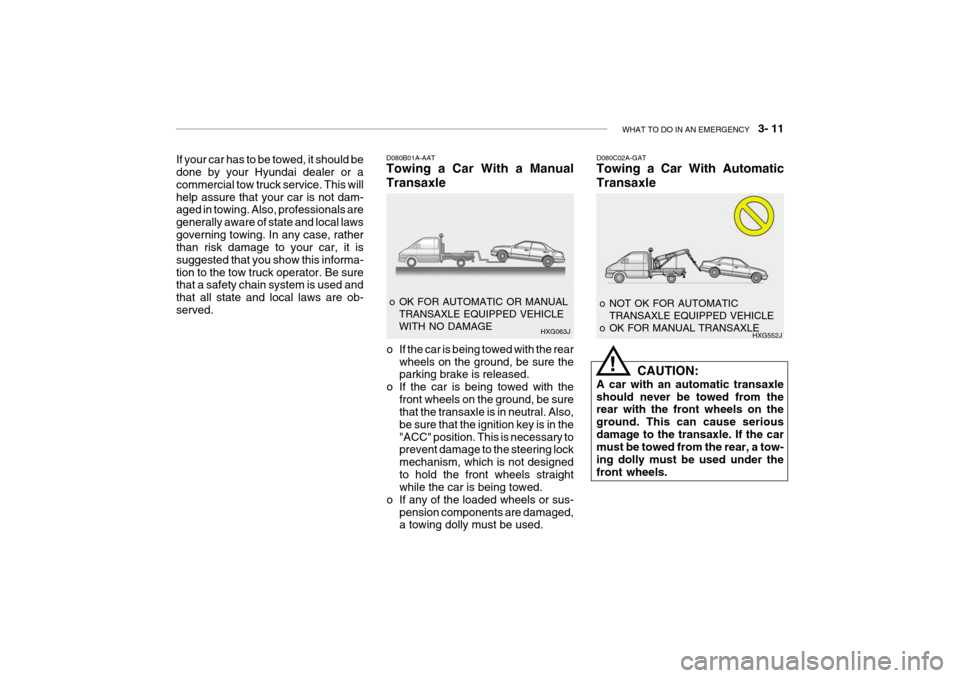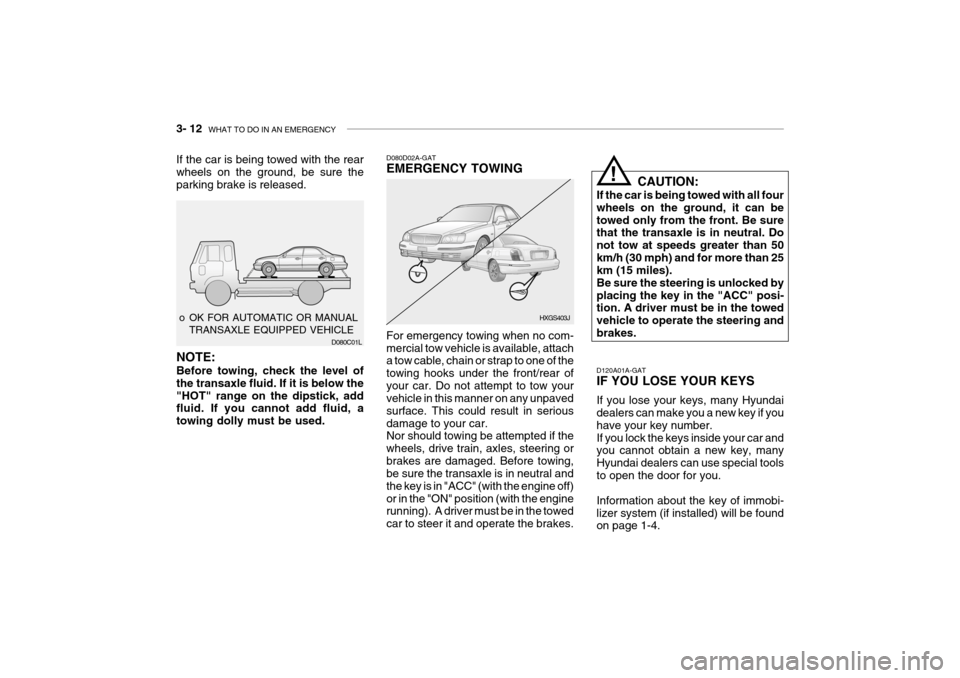2004 Hyundai Grandeur emergency towing
[x] Cancel search: emergency towingPage 144 of 235

DRIVING YOUR HYUNDAI 2- 11
C120A02A-AAT ANTI-LOCK BRAKE SYSTEM (If installed) The Anti-Lock Brake System (ABS) is designed to prevent wheel lock-upduring sudden braking or on hazard- ous road surfaces. The ABS control module monitors the wheel speed andcontrols the pressure applied to each brake. Thus, in emergency situations or on slick roads, ABS will increasevehicle control during braking. WARNING:
ABS will not prevent accidents due to improper or dangerous driving maneuvers. Even though vehiclecontrol is improved during emer- gency braking, always maintain a safe distance between you and ob-jects ahead. Vehicle speeds should always be reduced during extreme road conditions.The braking distance for cars equipped with an anti-lock braking system may be longer than for thosewithout it in the following road con- ditions. During these conditions the vehicleshould be driven at reduced speeds.
ating or shifting gears. On a slippery surface, an abrupt change in vehi- cle speed can cause the drive wheelsto lose traction and the vehicle to go out of control.!
!WARNING:
o Avoid high cornering speeds.
o Do not make quick steering wheel movements, such as sharp lane changes or fast, sharp turns.
o Always wear your seat belts.
o In a collision crash, an unbelted person is significantly more likelyto die than a person wearing aseatbelt.
o The risk of rollover is greatly in-
creased if you lose control ofyour vehicle at highway speeds.
o Loss of control often occurs if
two or more wheels drop off theroadway and the driver oversteers to reenter the roadway.
o In the event your vehicle leaves the roadway, do not steer sharply.Instead, slow down before pull- ing back into the travel lanes.
o Never exceed posted speed lim- its. o Excessive depressing of the
accelerater pedal in slippery driv-ing conditions such as pulling out of deep snow or mud may cause severe damage to thetransaxle. Rocking the vehicle is not recommended. Rather, use an appropriate towing method.
NOTE: During ABS operation, a slight pul- sation may be felt in the brake pedal when the brakes are applied. Also,a noise may be heard in the engine compartment while driving. These conditions are normal and indicatethat the anti-lock brake system is functioning properly.
Page 151 of 235

2- 18 DRIVING YOUR HYUNDAI
C180A01A-AAT USE OF LIGHTS Check your lights regularly for correct operation and always keep them clean.When driving during the day in condi- tions of poor visibility, it is helpful to drive with headlights on low beam.This enables you to be seen as well as to see.
C190A01A-GAT TRAILER OR VEHICLE TOWING If you are considering towing with your car, you should first check with your Province Department of Motor Vehicles
to determine their legal requirements.Since laws vary from province to prov- ince the requirements for towing trail- ers, cars, or other types of vehicles orapparatus may differ. Ask your Hyundai dealer for further details before towing.
C170A01A-AAT HIGH SPEED MOTORING Pre-Trip Inspections 1. Tires: Adjust the tire inflation pressures to specification. Low tire inflation pres-sures will result in overheating and possible failure of the tires. Avoid using worn or damaged tireswhich may result in reduced traction or tire failure. NOTE: Never exceed the maximum tire in- flation pressure shown on the tires. 2. Fuel, engine coolant and engine oil: High speed travel consumes more fuel than urban motoring. Do not forget tocheck both engine coolant and engine oil. 3. Drive belt: A loose or damaged drive belt may result in overheating of the engine.
C160K01A-AAT Carry Emergency Equipment Depending on the severity of the weather where you drive your car, you should carry appropriate emergency equipment. Some of the items youmay want to carry include tire chains, tow straps or chains, flashlight, emer- gency flares, sand, a shovel, jumpercables, a window scraper, gloves, ground cloth, coveralls, a blanket, etc.
C160J01A-AAT Don't Let Ice and Snow Accumu- late Underneath Under some conditions, snow and ice can build up under the fenders and interfere with the steering. When driv-ing in severe winter conditions where this may happen, you should periodi- cally check underneath the car to besure the movement of the front wheels and the steering components is not obstructed.
Page 156 of 235

3. WHAT TO DO IN AN EMERGENCY
If the Engine Will not Start .............................................................. 3-2
Jump Starting .................................................................................. 3-2
If the Engine Overheats .................................................................. 3-4
Spare Tire ....................................................................................... 3-5
If You Have a Flat Tire .................................................................... 3-5
If Your Car Must Be Towed ..........................................................3-10
Emergency Towing ....................................................................... 3-12
If You Lose Your Keys .................................................................. 3-12
3
Page 166 of 235

WHAT TO DO IN AN EMERGENCY 3- 11
D080C02A-GAT Towing a Car With Automatic Transaxle
CAUTION:
A car with an automatic transaxle should never be towed from the rear with the front wheels on the ground. This can cause seriousdamage to the transaxle. If the car must be towed from the rear, a tow- ing dolly must be used under thefront wheels. o NOT OK FOR AUTOMATIC
TRANSAXLE EQUIPPED VEHICLE
o OK FOR MANUAL TRANSAXLE HXG552JD080B01A-AAT Towing a Car With a Manual Transaxle
o If the car is being towed with the rear wheels on the ground, be sure the parking brake is released.
o If the car is being towed with the
front wheels on the ground, be surethat the transaxle is in neutral. Also, be sure that the ignition key is in the"ACC" position. This is necessary to prevent damage to the steering lock mechanism, which is not designedto hold the front wheels straight while the car is being towed.
o If any of the loaded wheels or sus-
pension components are damaged,a towing dolly must be used.
o OK FOR AUTOMATIC OR MANUAL
TRANSAXLE EQUIPPED VEHICLE WITH NO DAMAGE HXG063J
If your car has to be towed, it should be done by your Hyundai dealer or a commercial tow truck service. This willhelp assure that your car is not dam- aged in towing. Also, professionals are generally aware of state and local lawsgoverning towing. In any case, rather than risk damage to your car, it is suggested that you show this informa-tion to the tow truck operator. Be sure that a safety chain system is used and that all state and local laws are ob-served.
!
Page 167 of 235

3- 12 WHAT TO DO IN AN EMERGENCY
If the car is being towed with the rear wheels on the ground, be sure the parking brake is released.
o OK FOR AUTOMATIC OR MANUAL TRANSAXLE EQUIPPED VEHICLE D080C01LD080D02A-GAT EMERGENCY TOWING For emergency towing when no com- mercial tow vehicle is available, attach a tow cable, chain or strap to one of the towing hooks under the front/rear ofyour car. Do not attempt to tow your vehicle in this manner on any unpaved surface. This could result in seriousdamage to your car. Nor should towing be attempted if the wheels, drive train, axles, steering orbrakes are damaged. Before towing, be sure the transaxle is in neutral and the key is in "ACC" (with the engine off)or in the "ON" position (with the engine running). A driver must be in the towed car to steer it and operate the brakes. HXGS403J
CAUTION:
If the car is being towed with all fourwheels on the ground, it can betowed only from the front. Be sure that the transaxle is in neutral. Do not tow at speeds greater than 50km/h (30 mph) and for more than 25 km (15 miles). Be sure the steering is unlocked byplacing the key in the "ACC" posi- tion. A driver must be in the towed vehicle to operate the steering andbrakes. D120A01A-GAT IF YOU LOSE YOUR KEYS If you lose your keys, many Hyundai dealers can make you a new key if you have your key number.If you lock the keys inside your car and you cannot obtain a new key, many Hyundai dealers can use special toolsto open the door for you. Information about the key of immobi- lizer system (if installed) will be found on page 1-4.
!
NOTE: Before towing, check the level of the transaxle fluid. If it is below the"HOT" range on the dipstick, add fluid. If you cannot add fluid, a towing dolly must be used.
Page 234 of 235

INDEX 10- 5
Adjusting seat forwar d and rearward..................... 1-14
Adjusting seatback angle ................. ...................... 1-15
Seat cushion height adjustment............................ 1-15
Power Steering Fluid Level ............................. ..........6-24
R
Rear Seat Fold Down ............................................. 1-18 Rear Window Defroster Switch .................... 1-54 ~ 1-55
Replacement of light bulbs .......................................6-26
SSeat Front ........................................................... 1-11 ~ 1-15
Seat Warmer ............................................................. 1-17
Seat Belts 3-Point system ........................................... 1-21 ~ 1-23
Adjustable height ........................................ 1-21 ~ 1-22 Adjusting your seat be lt .........................................1-22
Care of seat belts .................................................. 1-20
Precautions ............................................................ 1-19
Spark Plugs ................................................... 6-10 ~ 6-11
Spectacle Case ......................................................... 1-63
Speedometer ............................................................. 1-47
Starting Procedure ...................................................... 2-4
Steering Wheel Freeplay .................. ........................ 6-19
Steering Wheel Electric T ilt and Telescopic ............. 1-75
Steering Wheel Tilt Lever .............. ...........................1-73
Stereo Radio Operation (H940B, H940A)
......................................... 1-97 ~ 1-99, 1-105 ~ 1-107
Stereo Sound System ................................... 1-95 ~ 1-96 Sun Visor
.................................................................. 1-73
Sunroof .......................................................... 1-59 ~ 1-61
T Tachometer ............................................................... 1-48
Theft-Alarm system ........................................... 1-8 ~ 1-9Tires Balancing .................................................................. 8-4
Chains ...................................................................... 8-4
If you have a flat ti re ................................... 3-5 ~ 3-10
Information ............................................................... 8-2
Pressure ......................................................... 8-2 ~ 8-3
Replacement ............................................................ 8-5
Rotation .................................................................... 8-4
Snow tires ................................................................ 8-3
Spare tire ................................................................. 3-5
Traction .................................................................... 8-4
Towing
A trailer (or vehicle) ................................... 2-18 ~ 2-21
Emergency ............................................................. 3-12
If your car must be towed ......................... 3-10 ~ 3-12
Traction Control System ............................... 2-12 ~ 2-13
Transaxle Automatic ..................................................... 2-7 ~ 2-11Automatic transaxle fluid checking ............ 6-14 ~ 6-15
Manual ..................................................................... 2-5
Manual transaxle Oil che cking ................... 6-13 ~ 6-14
Trip Computer ............................................... 1-55 ~ 1-56
Trip Odometer ............................................... 1-48 ~ 1-49
Trunk Lid ....................................................... 1-66 ~ 1-68